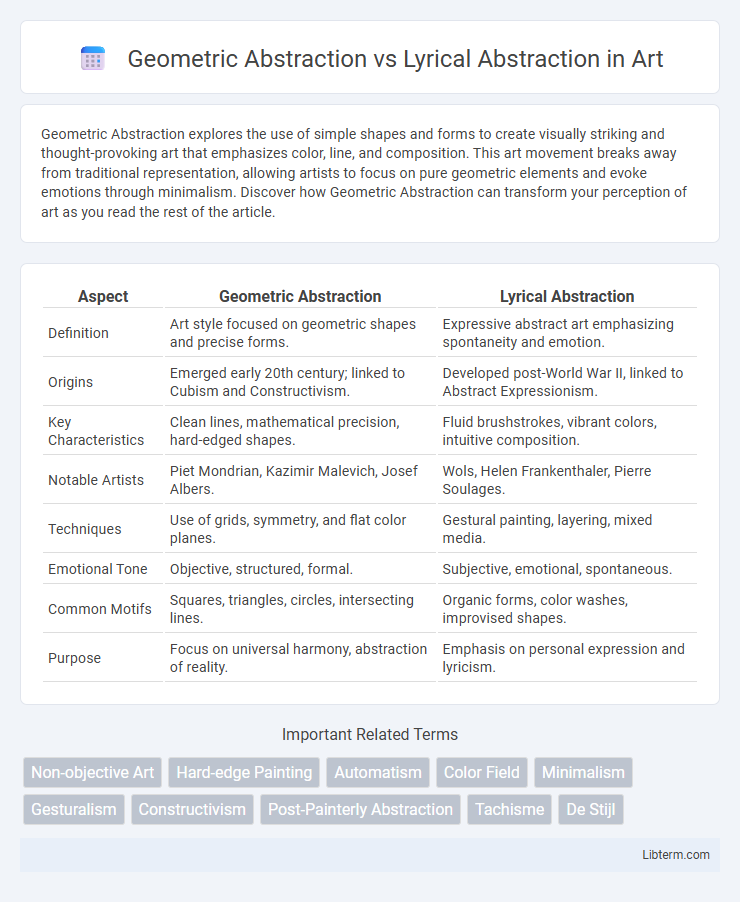Geometric Abstraction explores the use of simple shapes and forms to create visually striking and thought-provoking art that emphasizes color, line, and composition. This art movement breaks away from traditional representation, allowing artists to focus on pure geometric elements and evoke emotions through minimalism. Discover how Geometric Abstraction can transform your perception of art as you read the rest of the article.
Table of Comparison
| Aspect | Geometric Abstraction | Lyrical Abstraction |
|---|---|---|
| Definition | Art style focused on geometric shapes and precise forms. | Expressive abstract art emphasizing spontaneity and emotion. |
| Origins | Emerged early 20th century; linked to Cubism and Constructivism. | Developed post-World War II, linked to Abstract Expressionism. |
| Key Characteristics | Clean lines, mathematical precision, hard-edged shapes. | Fluid brushstrokes, vibrant colors, intuitive composition. |
| Notable Artists | Piet Mondrian, Kazimir Malevich, Josef Albers. | Wols, Helen Frankenthaler, Pierre Soulages. |
| Techniques | Use of grids, symmetry, and flat color planes. | Gestural painting, layering, mixed media. |
| Emotional Tone | Objective, structured, formal. | Subjective, emotional, spontaneous. |
| Common Motifs | Squares, triangles, circles, intersecting lines. | Organic forms, color washes, improvised shapes. |
| Purpose | Focus on universal harmony, abstraction of reality. | Emphasis on personal expression and lyricism. |
Introduction to Abstract Art Movements
Geometric Abstraction emphasizes precise shapes, lines, and mathematical forms often seen in works by artists like Piet Mondrian and Kazimir Malevich, highlighting structure and order. Lyrical Abstraction prioritizes expressive, fluid gestures and spontaneous compositions, exemplified by artists such as Wassily Kandinsky and Helen Frankenthaler, focusing on emotion and personal expression. Both movements emerged in the 20th century as significant branches of abstract art, reflecting contrasting approaches to form and meaning in modernism.
Defining Geometric Abstraction
Geometric Abstraction is defined by its use of precise shapes, lines, and mathematical forms to create non-representational compositions that emphasize structure and order. This art movement prioritizes clarity, symmetry, and the exploration of spatial relationships through geometric elements such as circles, squares, and triangles. It contrasts with Lyrical Abstraction, which favors expressive, fluid forms and emotional spontaneity over rigid, calculated design.
Characteristics of Lyrical Abstraction
Lyrical Abstraction is characterized by spontaneous, expressive brushwork and an emphasis on emotional intensity, often featuring fluid, organic shapes and vibrant color palettes. Unlike the precise, rigid forms of Geometric Abstraction, Lyrical Abstraction embraces improvisation and personal expression, creating dynamic compositions that evoke mood and atmosphere. This movement prioritizes freeform gestures and the physicality of paint, highlighting the artist's inner experience over structured design.
Historical Origins and Influences
Geometric Abstraction emerged in the early 20th century, influenced by Cubism and Constructivism, emphasizing precise shapes and mathematical forms, with pioneers like Piet Mondrian and Kazimir Malevich shaping its development. Lyrical Abstraction arose in the mid-20th century as a reaction against geometric rigidity, drawing inspiration from Abstract Expressionism and Surrealism, focusing on spontaneous, fluid, and emotive brushwork found in artists such as Helen Frankenthaler and Wassily Kandinsky. Both movements reflect distinct responses to modernism, with Geometric Abstraction rooted in rationality and order, while Lyrical Abstraction highlights personal expression and lyrical freedom.
Key Artists in Geometric Abstraction
Geometric Abstraction features key artists like Piet Mondrian, Kazimir Malevich, and Josef Albers, who emphasize precise shapes, symmetry, and mathematical forms to create visual harmony. These artists explore pure abstraction through geometric elements such as squares, circles, and lines, focusing on order and clarity. Their work contrasts with the spontaneous, expressive brushwork of Lyrical Abstraction, which prioritizes emotion and lyrical gesture over strict geometric structure.
Leading Figures in Lyrical Abstraction
Leading figures in Lyrical Abstraction such as Helen Frankenthaler, Joan Mitchell, and Sam Francis championed expressive, spontaneous brushwork and vibrant color fields, contrasting sharply with the rigid structure of Geometric Abstraction seen in artists like Piet Mondrian and Kazimir Malevich. Lyrical Abstraction emphasized emotional intensity and personal expression, often using fluid forms and dynamic compositions that evoked movement and depth. This movement expanded the boundaries of abstract art by prioritizing intuition and lyrical qualities over geometric precision and formalism.
Techniques and Visual Language
Geometric Abstraction employs precise shapes, clean lines, and systematic compositions to create a structured visual language characterized by mathematical clarity and order. Lyrical Abstraction emphasizes spontaneous brushwork, fluid forms, and vibrant color fields, prioritizing emotional expression and dynamic movement over rigid structure. The techniques in Geometric Abstraction involve measured, often hard-edged applications, while Lyrical Abstraction relies on free, gestural strokes that evoke a sense of lyricism and personal intuition.
Philosophical Underpinnings
Geometric Abstraction emphasizes rationality, order, and objective purity through precise shapes and mathematical forms, reflecting a philosophy rooted in universal truths and formal clarity. Lyrical Abstraction, by contrast, centers on spontaneity, emotion, and subjective experience, aligning with existentialist ideas that prioritize personal expression and the fluidity of perception. These differing philosophical underpinnings highlight the tension between structured rationalism and intuitive individualism in modern abstract art.
Impact on Contemporary Art
Geometric Abstraction, characterized by precise shapes and mathematical rigor, has profoundly influenced contemporary art by inspiring minimalist and conceptual art movements that emphasize structure, order, and clarity. Lyrical Abstraction, with its emphasis on spontaneity, emotional expression, and fluid forms, has contributed to contemporary art through its impact on abstract expressionism and neo-expressionism, promoting personal freedom and dynamic composition. Both styles continue to shape contemporary artistic practices by balancing controlled formality with expressive gestures, expanding the boundaries of abstraction in visual culture.
Comparing Geometric and Lyrical Abstraction
Geometric Abstraction emphasizes precise shapes, clean lines, and structured compositions, often using mathematical principles to create balance and order. Lyrical Abstraction, in contrast, highlights spontaneous, expressive brushstrokes and emotional intensity, favoring organic forms and vibrant color palettes. While Geometric Abstraction seeks clarity and uniformity, Lyrical Abstraction embraces fluidity and personal expression within abstract art.
Geometric Abstraction Infographic

 libterm.com
libterm.com